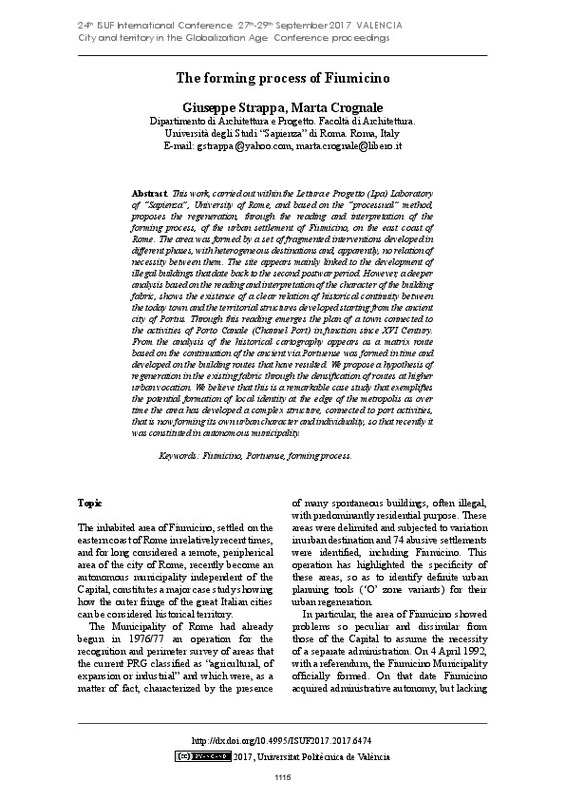JavaScript is disabled for your browser. Some features of this site may not work without it.
Buscar en RiuNet
Listar
Mi cuenta
Estadísticas
Ayuda RiuNet
Admin. UPV
The forming process of Fiumicino
Mostrar el registro sencillo del ítem
Ficheros en el ítem
| dc.contributor.author | Strappa, Giuseppe
|
es_ES |
| dc.contributor.author | Crognale, Marta
|
es_ES |
| dc.coverage.spatial | east=12.239711700000043; north=41.7735409; name= Fiumicino RM, Itàlia | es_ES |
| dc.date.accessioned | 2018-12-18T07:56:16Z | |
| dc.date.available | 2018-12-18T07:56:16Z | |
| dc.date.issued | 2018-04-20 | |
| dc.identifier.isbn | 9788490485743 | |
| dc.identifier.uri | http://hdl.handle.net/10251/114033 | |
| dc.description.abstract | [EN] his work, carried out within the Lettura e Progetto (Lpa) Laboratory of “Sapienza”, University of Rome, and based on the “processual” method, proposes the regeneration, through the reading and interpretation of the forming process, of the urban settlement of Fiumicino, on the east coast of Rome. The area was formed by a set of fragmented interventions developed in different phases, with heterogeneous destinations and, apparently, no relation of necessity between them. The site appears mainly linked to the development of illegal buildings that date back to the second postwar period. However, a deeper analysis based on the reading and interpretation of the character of the building fabric, shows the existence of a clear relation of historical continuity between the today town and the territorial structures developed starting from the ancient city of Portus. Through this reading emerges the plan of a town connected to the activities of Porto Canale (Channel Port) in function since XVI Century. From the analysis of the historical cartography appears as a matrix route based on the continuation of the ancient via Portuense was formed in time and developed on the building routes that have resulted. We propose a hypothesis of regeneration in the existing fabric through the densification of routes at hgher urban vocation. We believe that this is a remarkable case study that exemplifies the potential formation of local identity at the edge of the metropolis as over time the area has developed a complex structure, connected to port activities, that is now forming its own urban character and individuality, so that recently it was constituted in autonomous municipality. | es_ES |
| dc.format.extent | 10 | es_ES |
| dc.language | Inglés | es_ES |
| dc.publisher | Editorial Universitat Politècnica de València | es_ES |
| dc.relation.ispartof | 24th ISUF International Conference. Book of Papers | es_ES |
| dc.rights | Reconocimiento - No comercial - Sin obra derivada (by-nc-nd) | es_ES |
| dc.subject | Fiumicino | es_ES |
| dc.subject | Portuense | es_ES |
| dc.subject | Forming process | es_ES |
| dc.title | The forming process of Fiumicino | es_ES |
| dc.type | Capítulo de libro | es_ES |
| dc.type | Comunicación en congreso | es_ES |
| dc.identifier.doi | 10.4995/ISUF2017.2017.6474 | |
| dc.rights.accessRights | Abierto | es_ES |
| dc.description.bibliographicCitation | Strappa, G.; Crognale, M. (2018). The forming process of Fiumicino. En 24th ISUF International Conference. Book of Papers. Editorial Universitat Politècnica de València. 1115-1124. https://doi.org/10.4995/ISUF2017.2017.6474 | es_ES |
| dc.description.accrualMethod | OCS | es_ES |
| dc.relation.conferencename | 24th ISUF 2017 - City and Territory in the Globalization Age | es_ES |
| dc.relation.conferencedate | Septiembre 27-29,2017 | es_ES |
| dc.relation.conferenceplace | Valencia, Spain | es_ES |
| dc.relation.publisherversion | http://ocs.editorial.upv.es/index.php/ISUF/ISUF2017/paper/view/6474 | es_ES |
| dc.description.upvformatpinicio | 1115 | es_ES |
| dc.description.upvformatpfin | 1124 | es_ES |
| dc.type.version | info:eu-repo/semantics/publishedVersion | es_ES |
| dc.relation.pasarela | OCS\6474 | es_ES |








